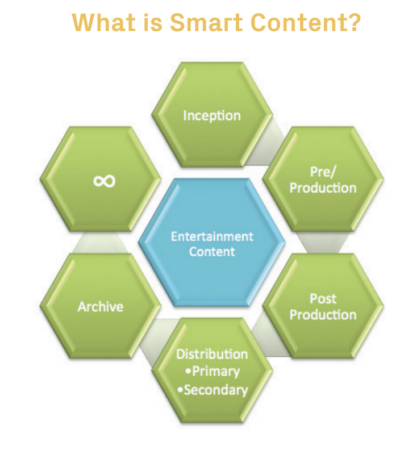
M&E Journal: Zooming in on Smart Content
As we gathered this spring for the Smart Content Summit, a few things were different. To get together, we didn’t have to brave Los Angeles traffic, wait for the valet, and find a comfortable spot at the Luxe Hotel or the Skirball Center.
Instead, we just clicked and we were instantly connect- ed with our community of data, library science and artificial intelligence (AI) nerds creating the next generation of entertainment technology.
We were still all there to talk about Smart Content, managing and connecting the data all around the content. But the changes that kept us apart have also changed how we think about that data and its impact.
Right from the start of the pandemic, data became our everyday. The volunteer-created COVID-19 dashboard (later adopted by Johns Hopkins) was a must-visit site and viewing and comparing and debating charts was everyone’s favorite pastime.
Forced inside, we also looked at our own data, with personal health trackers and data sites filling the void left by closed gyms and locked down neighborhoods. Data literacy and proficiency was, suddenly, just part of our lives.
Data was also behind the big shifts in the entertainment landscape. In response to the massive audience behavior changes, the digital, OTT and streamed future was accelerated. Movie release windows were rethought and big players made big bets on their own properties. Data is at the heart of all these new ventures, including, for the first time, data on consumer interaction with content.
In our Smart Content community, we’ve all watched as this has unfolded. And we’ve talked about how we still have a lot of work to do to deliver on these big ideas. We’ve talked about what kinds of data we need, how all that data flows between the systems, what kinds of data we can share, and what the limitations are of the current data tools including AI and machine learning.
 AT THE SMART CONTENT SUMMIT, WE GOT SOME ANSWERS:
AT THE SMART CONTENT SUMMIT, WE GOT SOME ANSWERS:
What data do we need? The closing keynote from Xavier Kochhar outlined how the big shift from technical data to descriptive metadata is key to improving the new generation of direct to consumer enter tainment products. If the new platforms don’t get data driven personalization and recommendations right, the users will “vote with their feet.” To get it right, they need to connect user profile data, usage and user behavior data and the data on what is inside the content. With this vision, the Smart Content view of data around the content is about to get a lot bigger.
How all that data is connected? The opening keynote from Anthony Accardo of Disney laid out the case for a data-driven supply chain. Starting with a mandate for investing in data from leadership, he then outlined the steps to connect and deliver data. This includes investing in knowledge management as a dedicated resource (your DAM, CMS etc. are not knowledge management systems), creating a roadmap to connect your systems and bring data governance, not data management, to every part of supply chain operations.
The result is a plan for data to be connected across the diverse system landscapes in every type of media organization and deliver the data needed for this next generation of enter entertainment products.
What data can we share? At the summit we heard from the Language Metadata Table (LMT) team. Language codes are both a great example of the data that can be shared and data that is critical for the new media landscape. Making sure everyone knows what Spanish is spoken in South America or how to code the hundreds of dialects that content is both created and distributed in is a winning proposition for everyone.
Content creators, distributors, tool vendors and of course the delivery platforms all need this information. With SMPTE now managing the standard, the LMT is going to find even more applications and continue to inspire everyone to not only solve data problems, but to share their solutions for the benefit of all.
What are the limitations? Many of the sessions at Smart Content were hands on looks at projects. A common theme, especially around AI and machine learning, is that there isn’t any magic or pixie dust that solves all your problems. Nate Adams, from Warner Bros., talked about their AI project to enhance the catalog.
It couldn’t be every bell and whistle, but with the right, manageable scope, they delivered real value. This community has been addressing better ways to manage and create the data all around the content for years. The practical approach we take and making sure we share what really works is a big part of why this is such a valuable community.
There is no doubt that now is the time for data in the entertainment industry. It’s behind the major shifts in the industry and highlighted by the changes in how we all consume media.
Events like the Smart Content Summit show just how important it is and how much more work we have to do and remind us that no matter how we gather in the future, the Smart Content community will be the right place to have these conversations.
* By Matt Turner, Strategic Advisor, Technologist, and Mary Yurkovic, Director, Smart Content Council, MESA
=============================================
Click here to download the complete .PDF version of this article
Click here to download the entire Spring 2021 M&E Journal
